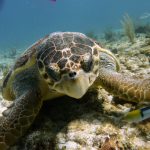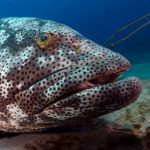Parrot Fish in Cancun
The Parrot fish in Cancun is another one of the many exploited coral reef fishes, hindering our ability to interpret fishery dynamics and develop conservation policies. In particular, parrotfishes (Labridae) represent a ubiquitous and ecologically important group that is increasingly prevalent in commercial and artisanal fisheries worldwide and is one of the most attractive species when you are Scuba Diving Cancun. We collect both fishery- industrial and fishery- local data to examine the effect of life histories on vulnerability to overexploitation in parrotfishes. Vulnerability for each species was derived from independent measures associated with both temporal (20-year catch records) and spatial datasets. Most life-history traits examined were significant predictors of vulnerability across species, but their relative utility differed considerably. Length-based traits (e.g., lengths at maturity and sex change, maximum length) were generally superior to age-based traits (e.g., life span), but one age-based trait, age at female maturation, was the best predictor. The results suggest that easily derived metrics such as maximum length can be effective measures of sensitivity to exploitation when applied to phylogenetically related multispecies assemblages, but more holistic and comprehensive age-based demographic data should be sought, especially in data-deficient and heavily impacted regions. Given the increasing prevalence of parrotfishes in the global coral reef harvest, species-specific responses demonstrate the capacity for heavy fishing pressure to alter parrotfish assemblages considerably.






